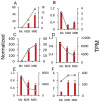Deep-sequencing analysis of the mouse transcriptome response to infection with Brucella melitensis strains of differing virulence
- PMID: 22216095
- PMCID: PMC3247208
- DOI: 10.1371/journal.pone.0028485
Deep-sequencing analysis of the mouse transcriptome response to infection with Brucella melitensis strains of differing virulence
Abstract
Brucella melitensis is an important zoonotic pathogen that causes brucellosis, a disease that affects sheep, cattle and occasionally humans. B. melitensis strain M5-90, a live attenuated vaccine cultured from B. melitensis strain M28, has been used as an effective tool in the control of brucellosis in goats and sheep in China. However, the molecular changes leading to attenuated virulence and pathogenicity in B. melitensis remain poorly understood. In this study we employed the Illumina Genome Analyzer platform to perform genome-wide digital gene expression (DGE) analysis of mouse peritoneal macrophage responses to B. melitensis infection. Many parallel changes in gene expression profiles were observed in M28- and M5-90-infected macrophages, suggesting that they employ similar survival strategies, notably the induction of anti-inflammatory and antiapoptotic factors. Moreover, 1019 differentially expressed macrophage transcripts were identified 4 h after infection with the different B. melitensis strains, and these differential transcripts notably identified genes involved in the lysosome and mitogen-activated protein kinase (MAPK) pathways. Further analysis employed gene ontology (GO) analysis: high-enrichment GOs identified endocytosis, inflammatory, apoptosis, and transport pathways. Path-Net and Signal-Net analysis highlighted the MAPK pathway as the key regulatory pathway. Moreover, the key differentially expressed genes of the significant pathways were apoptosis-related. These findings demonstrate previously unrecognized changes in gene transcription that are associated with B. melitensis infection of macrophages, and the central signaling pathways identified here merit further investigation. Our data provide new insights into the molecular attenuation mechanism of strain M5-90 and will facilitate the generation of new attenuated vaccine strains with enhanced efficacy.
© 2011 Wang et al.
Conflict of interest statement
Figures






Similar articles
-
Complete genome sequences of Brucella melitensis strains M28 and M5-90, with different virulence backgrounds.J Bacteriol. 2011 Jun;193(11):2904-5. doi: 10.1128/JB.00357-11. Epub 2011 Apr 8. J Bacteriol. 2011. PMID: 21478357 Free PMC article.
-
Comparison of genomes of Brucella melitensis M28 and the B. melitensis M5-90 derivative vaccine strain highlights the translation elongation factor Tu gene tuf2 as an attenuation-related gene.Infect Immun. 2013 Aug;81(8):2812-8. doi: 10.1128/IAI.00224-13. Epub 2013 May 28. Infect Immun. 2013. PMID: 23716607 Free PMC article.
-
A novel small RNA Bmsr1 enhances virulence in Brucella melitensis M28.Vet Microbiol. 2018 Sep;223:1-8. doi: 10.1016/j.vetmic.2018.07.007. Epub 2018 Jul 20. Vet Microbiol. 2018. PMID: 30173733
-
Transcriptome analysis of infected human macrophages between strains of Brucella melitensis and an omp31 mutant.Cell Mol Biol (Noisy-le-grand). 2024 Nov 24;70(10):9-15. doi: 10.14715/cmb/2024.70.10.2. Cell Mol Biol (Noisy-le-grand). 2024. PMID: 39605129
-
A Brucella melitensis M5-90 wboA deletion strain is attenuated and enhances vaccine efficacy.Mol Immunol. 2015 Aug;66(2):276-83. doi: 10.1016/j.molimm.2015.04.004. Epub 2015 Apr 17. Mol Immunol. 2015. PMID: 25899866
Cited by
-
MicroRNA-125b-5p suppresses Brucella abortus intracellular survival via control of A20 expression.BMC Microbiol. 2016 Jul 29;16(1):171. doi: 10.1186/s12866-016-0788-2. BMC Microbiol. 2016. PMID: 27473222 Free PMC article.
-
Whole-transcriptome, high-throughput RNA sequence analysis of the bovine macrophage response to Mycobacterium bovis infection in vitro.BMC Genomics. 2013 Apr 8;14:230. doi: 10.1186/1471-2164-14-230. BMC Genomics. 2013. PMID: 23565803 Free PMC article.
-
Systems biology analysis of Brucella infected Peyer's patch reveals rapid invasion with modest transient perturbations of the host transcriptome.PLoS One. 2013 Dec 9;8(12):e81719. doi: 10.1371/journal.pone.0081719. eCollection 2013. PLoS One. 2013. PMID: 24349118 Free PMC article.
-
The Twin-Arginine Translocation System Is Important for Stress Resistance and Virulence of Brucella melitensis.Infect Immun. 2020 Oct 19;88(11):e00389-20. doi: 10.1128/IAI.00389-20. Print 2020 Oct 19. Infect Immun. 2020. PMID: 32778612 Free PMC article.
-
Transcriptomic characterization of differential gene expression in oral squamous cell carcinoma: a meta-analysis of publicly available microarray data sets.Tumour Biol. 2016 Dec;37:15913–15924. doi: 10.1007/s13277-016-5439-6. Epub 2016 Oct 4. Tumour Biol. 2016. PMID: 27704359
References
-
- Seleem MN, Boyle SM, Sriranganathan N. Brucella: a pathogen without classic virulence genes. Vet Microbiol. 2008;129:1–14. - PubMed
-
- Gorvel JP, Moreno E. Brucella intracellular life: from invasion to intracellular replication. Vet Microbiol. 2002;90:281–297. - PubMed
-
- Fugier E, Pappas G, Gorvel JP. Virulence factors in brucellosis: implications for aetiopathogenesis and treatment. Expert Rev Mol Med. 2007;9:1–10. - PubMed
-
- Research group of Brucellosis (Harbin Veterinary Research Institute) Study on the brucella melitensis strain M5-90 vaccine. Chin J Cont End Dis. 1991;6:65–68. (In Chinese)
Publication types
MeSH terms
LinkOut - more resources
Full Text Sources
Molecular Biology Databases

